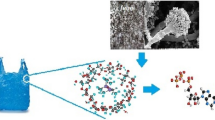Abstract
Most industrial wastes contain different organic mixtures, making important the investigation on the microbial destruction of composite substrates. The capability of microbes to remove harmful chemicals from polluted environments strongly depends on the presence of other carbon and energy substrates. The effect of mixtures of phenol- and methyl-substituted phenols (o-, m-, p-cresol) on the growth behaviour and degradation capacity of Trichosporon cutaneum strain was investigated. The cell-free supernatants were analysed by HPLC. It was established that the presence of o-, m- and p- cresol has not prevented complete phenol assimilation but had significant delaying effect on the phenol degradation dynamics. The mutual influence of phenol and p-cresol was investigated. We developed the kinetic model on the basis of Haldane kinetics, which used model parameters from single-substrate experiments to predict the outcome of the two-substrate mixture experiment. The interaction coefficients indicating the degree to which phenol affects the biodegradation of p-cresol and vice versa were estimated. Quantitative estimation of interaction parameters is essential to facilitate the application of single or mixed cultures to the bio-treatment of hazardous compounds.



Similar content being viewed by others
References
Aleksieva Z, Ivanova D, Godjevargova T, Atanasov B (2002) Degradation of some phenol derivatives by Trichosporon cutaneum R57. Proc Biochem 37:1215–1219
Alexievaa Z, Gerginova M, Zlateva P, Peneva N (2004) Comparison of growth kinetics and phenol metabolizing enzymes of Trichosporon cutaneum R57 and mutants with modified degradation abilities. Enzyme Microb Technol 3–4:242–247
Alvarez J, Vogel T (1991) Substrate interactions of benzene, toluene, and p-xylene during microbial degradation by pure cultures and mixed culture aquifer slurries. Appl Environ Microbiol 57:2981–2985
Bielefeldt A, Stensel H (1999) Modeling competitive inhibition effects during biodegradation of BTEX mixtures. Water Res 33:707–714
Chang M-K, Voice C, Criddle C (1993) Kinetics of competitive inhibition and cometabolism in the biodegradation of benzene, toluene and p-xylene by two. Biotechnol Bioeng 41:1057–1065
Dapaah S, Hill G (1992) Biodegradation of chlorophenol mixtures by Pseudomonas putida. Biotechnol Bioeng 40:1353–1358
Georgieva N, Yotova L, Betcheva R, Valchev I, Chadjiska C (2007) Biotransformation of lignin in linen with Trichosporon cutaneum R57. J Cellulose Chem Technol 2:25–27
Haigler B, Pettigrew C, Spain J (1992) Biodegradation of mixtures of substituted benzenes by Pseudomonas sp. strain JS150. Appl Environ Microb 58:2237–2244
Heinaru E, Viggor S, Vedler E, Truu J, Merima M, Heinaru A (2001) Reversible accumulation of p-hydroxybenzoate and catechol determines the sequential decomposition of phenolic compounds in mixed substrate cultivation in pseudomonads. FEMS Microbiol Ecol 37:79–89
Hill G, Milne B, Nawrocki P (1996) Cometabolic degradation of 4-chlorophenol by Alcaligenes eutrophus. Appl Microbiol Biotechnol 46:163–168
Hinteregger C, Leitner R, Loidl M, Ferschl A, Streichsbier F (1992) Degradation of phenol and phenolic compounds by Pseudomonas putida EKII. Appl Microbiol Biotechnol 37:252–259
Hutchinson D, Robinson C (1988) Kinetics of the simultaneous batch degradation of p-cresol and phenol by Pseudomonas putida. Appl Microbiol Biotechnol 29:599–604
Kar S, Swaminathan T, Baradarajan A (1997) Biodegradation of phenol and cresol isomer mixtures by Arthrobacter. World J Microbiol Biotechnol 13:659–663
Muller R, Babel W (1996) Growth rate-dependent expression of phenol-assimilation pathway in Alcaligenes eutrophus JMP 134-the influence of formate as an auxiliary energy source on phenol conversion characteristics. Appl Microbiol Biotechnol 46:156–162
Neujahr H, Varga J (1970) Degradation of phenols by intact cells and cell-free preparations of Trichosporon cutaneum. Eur J Biochem 13:37–44
Oh Y-S, Shareefdeen Z, Baltzis B, Bartha R (1994) Interactions between benzene, toluene and p-xylene during their biodegradation. Biotechnol Bioeng 44:533–538
Powlowski B, Dagley S (1985) β-Ketoadipate pathway in Trichosporon cutaneum modified for methyl-substituted metabolites. J Bacteriol 16:1126–1135
Reardon K, Mosteller D, Rogers J (2000) Biodegradation kinetics of benzene, toluene and phenol as single and mixed substrates for Pseudomonas putida. Biotechnol Bioeng 69:385–400
Reardon K, Mosteller D, Rogers J, Teau N, Kim K-H (2002) Biodegradation kinetics of aromatic hydrocarbon mixtures by pure and mixed bacterial cultures. Environ Health Perspect 110:1005–1011
Rogers J, Reardon K (2000) Modelling substrate interactions during the biodegradation of mixtures of toluene and phenol by Burkholderia species JS150. Biotechnol Bioeng 70:428–435
Schmidt S, Alexander M (1985) Effects of dissolved organic carbon and second substrates on the biodegradation of organic compounds at low concentration. Appl Environ Microbiol 49:822–827
Shivarova N, Zlateva P, Atanasov B, Christov A, Peneva N, Gerginova M, Alexieva Z (1999) Phenol utilization by filamentous yeast Trichosporon cutaneum. Bioproc Eng 20:325–328
Yan J, Jianping W, Jing B, Daoquan W, Zongding H (2006) Phenol biodegradation by the yeast Candida tropicalis in the presence of m-cresol. Biochem Eng J 29:227–234
Zlateva P, Gerginova M, Manasiev Y, Atanasov B, Peneva N, Dimova N, Alexieva Z (2005) Kinetic parameters determination of the phenolic derivatives assimilation by Trichosporon cutaneum R57. Biotechnol Biotechnol Equip 19:93–97
Acknowledgments
The support by National Counsel of Science Research of the Bulgarian Ministry of Education and Science under project K 1205/02 is gratefully acknowledged.
Author information
Authors and Affiliations
Corresponding author
Rights and permissions
About this article
Cite this article
Alexieva, Z., Gerginova, M., Manasiev, J. et al. Phenol and cresol mixture degradation by the yeast Trichosporon cutaneum . J Ind Microbiol Biotechnol 35, 1297–1301 (2008). https://doi.org/10.1007/s10295-008-0410-1
Received:
Accepted:
Published:
Issue Date:
DOI: https://doi.org/10.1007/s10295-008-0410-1




